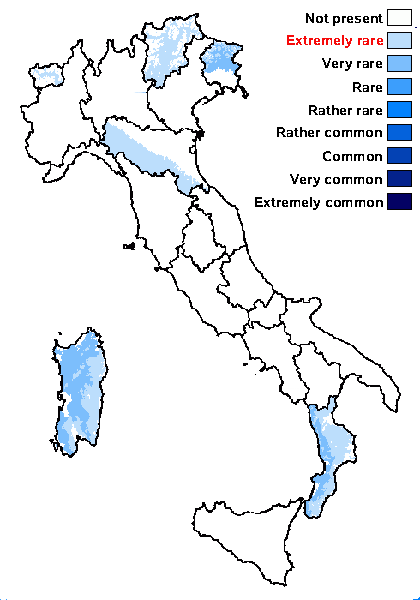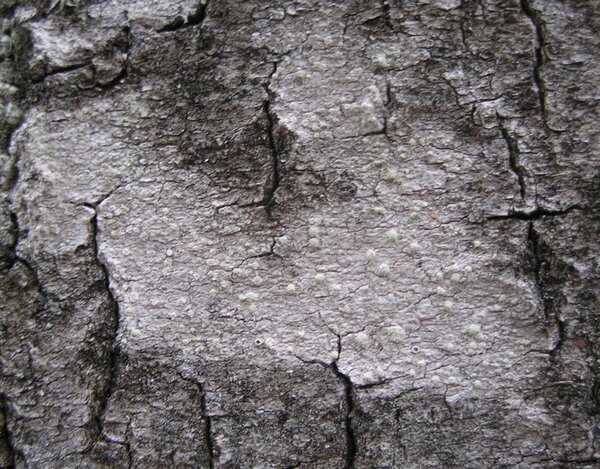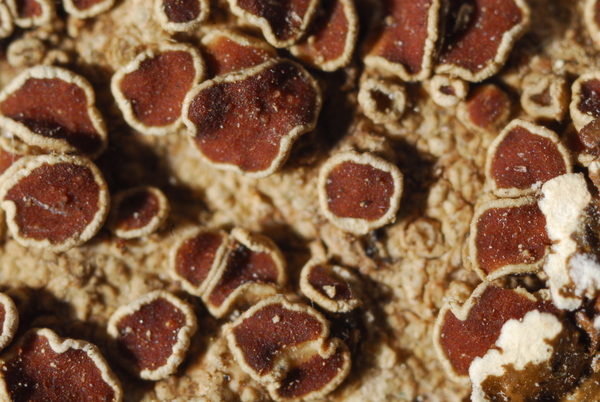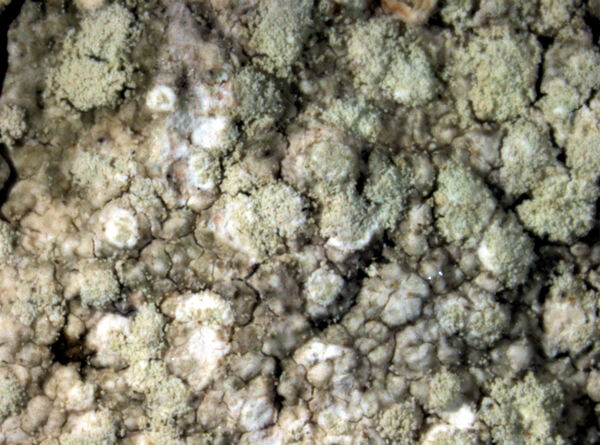Lecanora impudens Degel.
Svensk Bot. Tidskr., 38: 50, 1944.
Synonyms: Lecanora chloropolia auct. p.p.; Lecanora chloropolia f. maculata Erichsen; Lecanora maculata (Erichsen) Almb.; Pertusaria farinacea H. Magn.; Pertusaria maculata Erichsen
Distribution: N - Frl, TAA (Nascimbene & al. 2014, Nascimbene 2014, Nascimbene & Marini 2015, Trindade & al. 2021), VA (Isocrono & Ongaro 2021, Ravera & al. 2021c, Ongaro & al. 2022), Emil (Fariselli & al. 2020). C - Sar (Zedda 2002, 2002b, Malíček & al. 2017). S - Cal (Puntillo 1996).
Description: Thallus crustose, episubstratic, smooth to warted, grey, whitish grey or yellowish white, sorediate, the soralia maculiform, orbicular, 0.3-0.6(-1) mm across, rarely confluent, concave or flat when young, later convex, when young sometimes delimited by a thin basal thalline rim; soredia finely granulose, 40-60 µm thick, pale grey to more often pale yellow. Apothecia rare, lecanorine, sessile or slightly constricted at base, 0.5-1(-1.2) mm across, with a reddish brown, shiny disc, and a smooth, often sorediate thalline margin. Thalline exciple distinctly corticate, the cortex basally thickened, with abundant, small crystals insoluble in K; epithecium yellow-brown, the pigment not dissolving in K, without crystals; hymenium colourless, 50-80 µm high; hypothecium colourless to pale yellow, 20-45 µm high. Asci 8-spored, clavate, very thin-walled, with a K/I+ blue, tall tholus penetrated by a faintly amyloid apical cushion, the wall K/I-, surrounded by a blue outer layer, Lecanora-type. Ascospores 1-celled, hyaline, ellipsoid, (10-)12-15 x (5.5-)8-10 µm, the wall <1 µm thick. Photobiont chlorococcoid. Spot tests: thallus and margin of apothecia K+ yellow, C-, KC-, P+ faintly yellow. Chemistry: atranorin (major), chloratranorin, zeorin, an unknown terpenoid (minor or accessory), and sometimes traces of fatty acids.Note: a temperate species found on base-rich bark, especially on isolated Fraxinus in humid riparian woodlands. According to Malícek (in litt.), who examined the original material, the record of L. farinaria Borrer from Sardinia by Zedda (2002, 2002b), actually refers to this species, which is included in the Italian red list of epiphytic lichens as “Vulnerable” (Nascimbene & al. 2013c). See also note on L. allophana f. sorediata. For further details see Malíček & al. (2017).
Growth form: Crustose
Substrata: bark
Photobiont: green algae other than Trentepohlia
Reproductive strategy: mainly asexual, by soredia, or soredia-like structures (e.g. blastidia)
Most common in areas with a humid-warm climate (e.g. most of Tyrrenian Italy)
Commonnes-rarity: (info)
Alpine belt: absent
Subalpine belt: absent
Oromediterranean belt: absent
Montane belt: extremely rare
Submediterranean belt: extremely rare
Padanian area: absent
Humid submediterranean belt: very rare
Humid mediterranean belt: absent
Dry mediterranean belt: absent

Predictive model
Herbarium samples
Growth form: Crustose
Substrata: bark
Photobiont: green algae other than Trentepohlia
Reproductive strategy: mainly asexual, by soredia, or soredia-like structures (e.g. blastidia)
Most common in areas with a humid-warm climate (e.g. most of Tyrrenian Italy)
Commonnes-rarity: (info)
Alpine belt: absent
Subalpine belt: absent
Oromediterranean belt: absent
Montane belt: extremely rare
Submediterranean belt: extremely rare
Padanian area: absent
Humid submediterranean belt: very rare
Humid mediterranean belt: absent
Dry mediterranean belt: absent

Predictive model
| Herbarium samples |
 INDEX FUNGORUM
INDEX FUNGORUM
 GBIF
GBIF
 DOLICHENS
DOLICHENS







